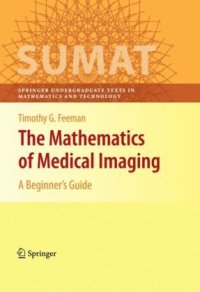
Ebook: The Mathematics of Medical Imaging: A Beginner’s Guide
Author: Timothy G. Feeman (auth.)
- Genre: Medicine
- Tags: Functional Analysis, Imaging / Radiology, Integral Transforms Operational Calculus, Math Applications in Computer Science, Computer Imaging Vision Pattern Recognition and Graphics, Biomedical Engineering
- Series: Springer Undergraduate Texts in Mathematics and Technology
- Year: 2010
- Publisher: Springer-Verlag New York
- Edition: 1
- Language: English
- pdf
A Beginner's Guide to the Mathematics of Medical Imaging presents the basic mathematics of computerized tomography – the CT scan – for an audience of undergraduates in mathematics and engineering. Assuming no prior background in advanced mathematical analysis, topics such as the Fourier transform, sampling, and discrete approximation algorithms are introduced from scratch and are developed within the context of medical imaging. A chapter on magnetic resonance imaging focuses on manipulation of the Bloch equation, the system of differential equations that is the foundation of this important technology.
The text is self-contained with a range of practical exercises, topics for further study, and an ample bibliography, making it ideal for use in an undergraduate course in applied or engineering mathematics, or by practitioners in radiology who want to know more about the mathematical foundations of their field.
This text explores medical imaging, one of the most significant areas of recent mathematical applications, in a concise manner accessible to undergraduate students. The author emphasizes the mathematical aspects of medical imaging, including not only the theoretical background, but also the role of approximation methods and the computer implementation of the inversion algorithms.
In twenty-first century health care, CAT scans, ultrasounds, and MRIs are commonplace. Significant computational advances, along with the development, design, and improvement of the machines themselves, can only occur in conjunction with a proper understanding of the mathematics. Some topics covered include x-rays, the Radon Transform, back projection, the Fourier Transform, filters and convolution, and discrete image reconstruction.
This book is inherently interdisciplinary in nature, and therefore is appropriate for students of engineering, physics, and computer science, in addition to mathematics. A working knowledge of multivariable calculus, as well some basic knowledge of differential equations and basic linear algebra and matrix methods, are mathematical prerequisites.